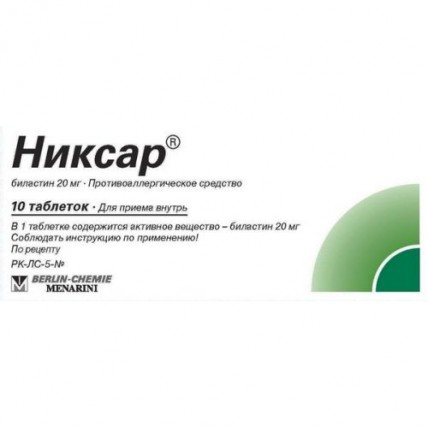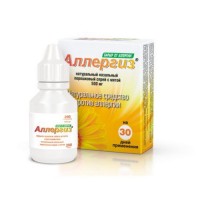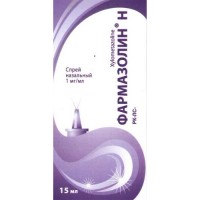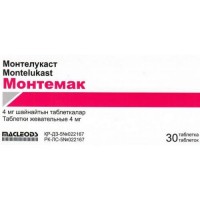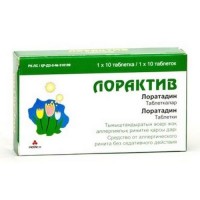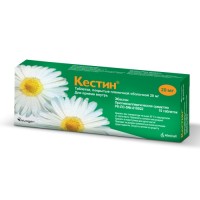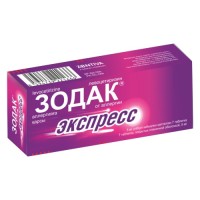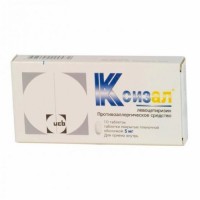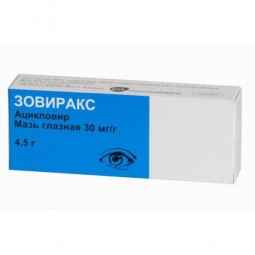Nixar (Bilastine) 20 mg x 10 tablets
- $12.00
Out Of Stock
Structure
One tablet contains
active substance - bilastine 20 mg
excipients: microcrystalline cellulose, sodium starch glycolate (type A), colloidal anhydrous silicon dioxide, magnesium stearate
Indications for use
- symptomatic treatment of allergic rinoconjunctivitis (seasonal and perennial) and urticaria
Method of administration and dosage
Used internally
Adults and adolescents (12 years and older)
The recommended dose is 20 mg (1 tablet) once a day to relieve the symptoms of allergic rhinoconjunctivitis (seasonal and perennial) and urticaria.
The tablet should be taken orally 1 hour before or 2 hours after a meal or fruit juice. It is recommended to take the daily dose at one time.
Elderly patients
Elderly patients do not need to adjust the dose. The experience of using the drug in patients over 65 years of age is insignificant.
Children under 12 years of age
The safety and effectiveness of bilastine in children under 12 years of age have not been established.
Renal dysfunction
No dose adjustment is required in patients with impaired renal function.
Liver dysfunction
There is no experience of clinical use of the drug in patients with impaired liver function. Since bilastine is not metabolized and is excreted mainly through the kidneys, impaired liver function should not lead to an increase in its systemic exposure to a dangerous level. Therefore, dose adjustment is not required in patients with impaired liver function.
The duration of treatment is determined individually by the attending physician.
For patients with allergic rhinitis, the drug should be used only during contact with allergens. In patients with seasonal allergic rhinitis, treatment can be discontinued after symptoms resolve and resumed when symptoms return. For patients with perennial allergic rhinitis, the drug can be used continuously during the period of contact with allergens. In patients with urticaria, the duration of treatment depends on the nature and duration of the symptoms, as well as on their dynamics.
Side effects
Side effects are classified into the following frequency categories:
very often (≥ 1/10)
often (≥ 1/100 but <1/10)
sometimes (≥ 1/1000, but <1/100)
rarely (≥ 1/10000, but <1/1000)
very rare (<1/10000)
Unknown (available data do not allow assessment)
Side effects that occur rarely and very rarely, as well as those whose frequency is unknown, are not indicated in the table.
| Class of organs and organ systems | Bilastine 20 mg | Bilastine at any dose | Placebo | |
| Frequency Side effect | N = 1697 | N = 2525 | N = 1362 | |
| Infections and parasitic diseases | ||||
| Infrequently | Oral herpes | 2 (0.12%) | 2 (0.08%) | 0 (0.0%) |
| Eating and metabolic disorders | ||||
| Infrequently | Increased appetite | 10 (0.59%) | 11 (0.44%) | 7 (0.51%) |
| Mental disorders | ||||
| Infrequently | Anxiety | 6 (0.35%) | 8 (0.32%) | 0 (0.0%) |
| Insomnia | 2 (0.12%) | 4 (0.16%) | 0 (0.0%) | |
| Ear and labyrinth disorders | ||||
| Infrequently | Noise in ears | 2 (0.12%) | 2 (0.08%) | 0 (0.0%) |
| Dizziness | 3 (0.18%) | 3 (0.12%) | 0 (0.0%) | |
| Heart disorders | ||||
Additional research methods
Uncommon Increased activity of gamma-glutamyl transferase 7 (0.41%) 8 (0.32%) 2 (0.15%)
Increased activity of alanine aminotransferase 5 (0.30%) 5 (0.20%) 3 (0.22%)
Increased activity of aspartate aminotransferase 3 (0.18%) 3 (0.12%) 3 (0.22%)
Elevated blood creatinine 2 (0.12%) 2 (0.08%) 0 (0.0%)
Elevated blood triglycerides 2 (0.12%) 2 (0.08%) 3 (0.22%)
Weight gain 8 (0.47%) 12 (0.48%) 2 (0.15%)
Contraindications
- hypersensitivity to the active substance (bilastine) and to any of the excipients
-Children under 12 years old
-pregnancy and lactation period
Drug interactions
Interaction with food: food reduces the bioavailability of bilastine after oral administration by 30%.
Interaction with grapefruit juice: in the case of using bilastine at a dose of 20 mg simultaneously with grapefruit juice, the bioavailability of bilastine decreased by 30%. A similar effect can be observed with other fruit juices. The degree of reduction in bioavailability can vary depending on the manufacturer of the juice and the fruit from which it is derived. This interaction is due to the ability of fruit components to suppress the activity of the organic anion carrier protein OATP1A2, for which bilastine is a substrate. Drugs that are substrates or inhibitors of OATP1A2, such as ritonavir or rifampicin, can also reduce the plasma bilastine concentration.
Interaction with ketoconazole or erythromycin: in the case of taking bilastine simultaneously with ketoconazole or erythromycin, the PFC of bilastine increased by 2 times, and Cmax increased by 2-3 times. Such effects can be explained by the interaction at the level of carrier proteins responsible for the elimination of drugs from intestinal cells, since bilastine is a substrate of P-glycoprotein and is not metabolized. The safety profile of bilastine, on the one hand, and ketoconazole or erythromycin, on the other, do not appear to be affected by these effects. Other drugs that are substrates or inhibitors of P-glycoprotein, for example, cyclosporine, can also increase the concentration of bilastine in plasma.
Interaction with diltiazem: in the case of taking bilastine at a dose of 20 mg simultaneously with diltiazem at a dose of 60 mg, Cmaxbilastine increased by 50%. This effect can be explained by the interaction at the level of carrier proteins responsible for the elimination of drugs from intestinal cells; this effect does not appear to affect the safety profile of bilastine.
Interaction with alcohol:
after the simultaneous use of alcohol and bilastine at a dose of 20 mg, psychomotor functions were at the same level as after the simultaneous use of alcohol and placebo.
Interaction with lorazepam: in the case of the use of bilastine at a dose of 20 mg simultaneously with lorazepam at a dose of 3 mg for 8 days, no increase in the suppressive effect of lorazepam on the central nervous system was detected.
Special instructions
In patients with moderate or severe renal impairment, the use of bilastine concurrently with P-glycoprotein inhibitors (ketoconazole, erythromycin, cyclosporine, ritonavir, diltiazem, etc.) may lead to an increase in plasma bilastine concentration and thereby increase the risk of its side effects. For this reason, patients with moderate and severe renal impairment should not use bilastine concurrently with P-glycoprotein inhibitors.
Fertility: Clinical data are limited or not available.
Pregnancy and lactation
Pregnancy: There is limited or no data on the use of bilastine in pregnant women.
Lactation: there is no data on whether bilastine passes into breast milk in women. The excretion of bilastine in milk in animals has not been studied. The decision to continue or terminate breastfeeding, as well as to continue or discontinue therapy with Nixar® should be made taking into account the benefits of breastfeeding for the child, on the one hand, and the mother's need for bilastine therapy, on the other.
Application in pediatrics
The safety and efficacy of bilastine in children under 12 years of age has not been confirmed.
Features of the effect of the drug on the ability to drive a vehicle or potentially dangerous mechanisms
According to a study that examined the effect of bilastine on the ability to drive, the use of bilastine at a dose of 20 mg does not affect the ability to drive. However, patients should be informed that in very rare cases, the drug can cause drowsiness and thereby affect the ability to drive vehicles and maintain mechanisms.
Overdose
Symptoms: data regarding acute overdose were obtained only in clinical studies that were part of the bilastine development program. Against the background of the use of bilastine in doses that exceeded the therapeutic one by 10-11 times (220 mg in the case of a single use, or 200 mg / day if used for 7 days), side effects in healthy volunteers occurred 2 times more often than against the background placebo use. The most common side effects reported were dizziness, headache, and nausea. There were no serious side effects and no significant increase in the QTc interval.
In a crossover study measuring QT / QTc intervals, in which 30 healthy volunteers studied the effect of repeated use of bilastine (at a dose of 100 mg / day for 4 days) on ventricular repolarization, no statistically significant lengthening of the QTc interval was found.
Treatment: symptomatic and supportive treatment is recommended.
A specific antidote for bilastine is not known.
Storage conditions
Store at a temperature not exceeding 30 ° C.
Keep out of the reach of children!
Shelf life - 5 years
After the expiration of the shelf life, the medicinal product cannot be used.
